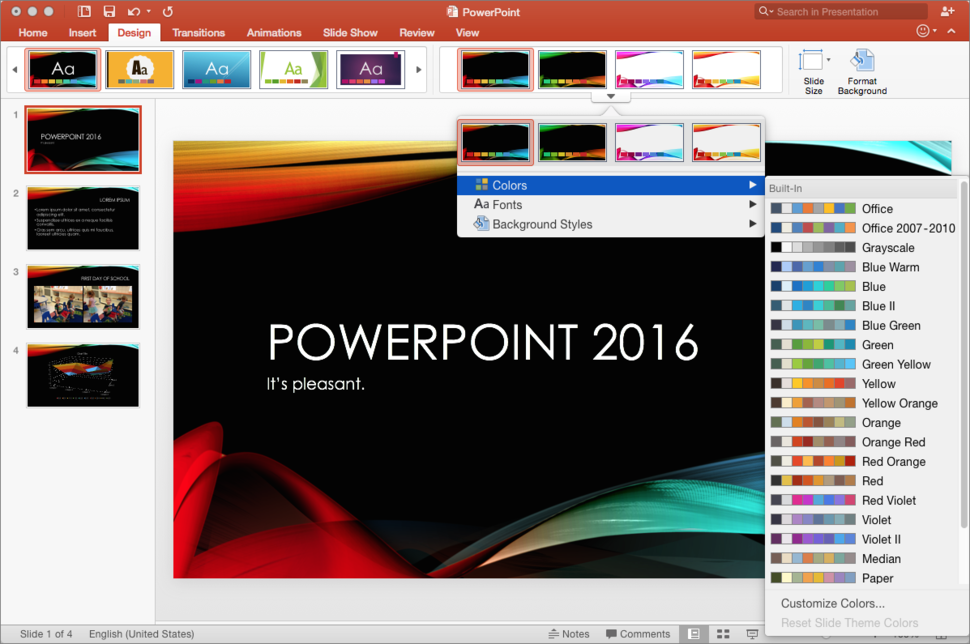
Where Is The Design Tab In Powerpoint For Mac 2011
Change slide backgrounds. PowerPoint 2019 for Mac, PowerPoint 2016 for Mac; PowerPoint for Mac 2011; Every theme includes a background. The background can be plain white, a solid or gradient color fill, a texture or pattern fill, or a picture. When you change to a different theme, the background is replaced. On the Design tab, in. How to Edit the Footer in PowerPoint on PC or Mac. This wikiHow teaches you how to edit the footer in Microsoft PowerPoint notes, handouts, and slide presentations. Open PowerPoint on your PC or Mac. It's in the All Apps section of the.
Click the Slide button to switch to Normal View.
You can’t mess with tabs or indents in Notes Page View or Slide Sorter View.
If the rulers aren’t visible, summon them by clicking the View tab on the Ribbon and then selecting the Ruler check box in the Show/Hide group.
Rulers appear above and to the left of the presentation window and show the current tab and indentation settings.
Select the text object whose tabs or indents you want to change.
Each text object has its own tabs and indents settings. After you click a text object, the ruler shows that object’s tabs and indents.
Select the text object whose tabs or indents you want to change.
Each text object has its own tabs and indents settings. After you click a text object, the ruler shows that object’s tabs and indents. Scanprisa 640u drivers for mac windows 7.
Click the ruler to add a tab stop.
Move the cursor to the ruler location where you want to add a tab stop and then click. A tab stop appears.
Grab the indentation doohickey and then drag it to change the indentation.
The indentation doohickey (that’s not its official name) is the control that looks like an hourglass sitting on a little box, normally positioned at the left side of the ruler.
It actually consists of three parts: the top upside-down triangle sets the indentation for the first line of the paragraph, the middle triangle sets the indentation for the remaining lines of the paragraph, and the box at the bottom sets the indentation for the paragraph. Try dragging the different parts of the indentation doohickey to see what happens.
Introducing the Ribbon
Ribbon Contents
Introducing the Ribbon
The Ribbon along with its tabs makes its debut in MicrosoftPowerPoint 2011 for Mac. Unlike the PowerPoint versions on Windows though, theRibbon does not replace all the menus and toolbars that were found in PowerPoint 2008 and older Mac versions.
The Ribbon is essentially a long strip that's fixed in size (highlighted in red within Figure 1) so thatyou cannot change its width or height. The Ribbon includes several tabs -- and each tab is named as you can see in Figure 1.
Figure 1: Ribbon in PowerPoint 2011
Ribbon Content
The Ribbon contains many interface elements:

- Tabs: The Ribbon consists of fixed tabs such as Home, Themes, Tables, etc. Each tab contains sets of tools to createand edit presentations. By default, the Developer tab is not visible in the Ribbon although you canenable it yourself.
- Contextual Tabs are special tabs in the Ribbon that are not visible all the time -- they only make an appearance when you areworking with a particular slide object which can be edited using special options. Figure 2 shows the Format tab(highlighted in red) which is only activated when a shape or another drawing object is selected on the slide.
Figure 2: Format tab in the Ribbon- Group: A group of related tools within a tab is known as a Group. Figure 3 shows the Shape Styles groupwithin the Format tab.
Figure 3: Shapes Styles group- A Gallery is collection of styles or properties -- most galleries can be seen as drop-down galleries as shown inFigure 4. To access the drop-down galleries, you click the More button (which is explained next). The figure below shows the ShapeStyles gallery -- all available styles can be seen as small preview thumbnails.
Figure 4: Shape Style Gallery- The More button expands a gallery within a Ribbon tab so that all or more options can be seen. Figure 5shows you the More button at the bottom (highlighted in red) of the Shape Styles group, the More button onlyappears when you place your cursor over the thumbnail area of the Shape Styles (refer to Figure 5 again). Just click the More button toopen the gallery. The two arrow buttons at the right and left end of the Shape Styles thumbnail area are used to scroll inside the gallery withoutexpanding it.
Figure 5: More button- The Down Arrow is a small downward pointing triangle that's placed next to many buttons on the Ribbon tabs. When clicked,this displays a gallery or an additional option/submenu related to the selected tools -- you can see the Down Arrow (highlighted inred) next to the Fill option in Figure 6.
Figure 6: Down Arrow